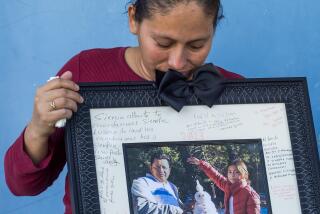Death by ‘nail-polish driver’ launches lone crusade
- Share via
Reporting from Waukegan, Ill. — With the setting sun glaring in his eyes, a man in a black hat and coat peered from behind bushes outside a suburban warehouse, looking for the woman who forever changed his life.
Greg Zaffke II never pictured himself doing surveillance. But that was before Lora Hunt, a church-going grandmother who was painting her nails while driving, smashed into the back of a motorcycle ridden by Zaffke’s mother, killing her instantly.
Convicted of reckless homicide, Hunt was sentenced in July to 18 months of periodic imprisonment, which keeps her locked up at night but lets her out for work during the day. The former nurse now spends up to four hours a day commuting about 70 miles each way between the jail complex in Waukegan and her job at an industrial company in New Lenox.
Zaffke, 32, wanted to see for himself that Hunt was following the rules of her sentencing. He stopped only when informed by a Chicago Tribune reporter that authorities were tracking Hunt’s movements with a GPS device.
“I’m not looking to stalk her,” Zaffke said. “When you’ve taken someone’s life and spend most of the day out of jail, it boggles the mind.”
Zaffke’s complaint notes the complication of periodic imprisonment. Widely varying rules — determined case by case by judges and jailers, but not detailed publicly — can rile victims’ relatives.
Work release struck Zaffke as too lenient, and the shifting rules make him only more uneasy.
The case of the “nail-polish driver” roused a media frenzy when the crash occurred near Lake Zurich in May 2009.
Hunt was on her way to deliver a crib to her daughter and tried to touch up her nails while driving. She testified that she saw a yellow light and planned to go through the intersection, but didn’t see Anita Zaffke, 56, who had stopped on her motorcycle in front of her. Zaffke, thrown 200 feet, died immediately.
Hunt, 49, doesn’t actually sleep in jail. She spends the night in a nearby facility known as the Community Based Corrections Center, which typically houses about 100 periodic-release inmates in dormitory-style rooms and common areas rather than in cells.
To address Zaffke’s concerns, a Tribune reporter waited outside the corrections center one night last month when Hunt arrived about 7 p.m. Asked about allegations that her punishment had been too light, she started sobbing as she leaned against the door frame of her temporary home. She had just come from visiting her probation officer, she said.
“No one knows the price I’ve paid and that I’ve paid every day,” Hunt said.
Asked later if she stopped to see a movie or for any other diversion, Hunt said, “There’s no time for that. They don’t allow time for that.”
Jail officials would not specify how long Hunt is allowed out each day, but say her employer has verified her work hours.
Hunt’s attorney, Jeffrey Tomczak, said the GPS makes Zaffke’s tracking of Hunt unnecessary.
“Lora has been fully compliant [with her sentence] from Day One,” he said.
Zaffke said he has no further plans to follow Hunt. But he still thinks she is given too much free time.
“I’ve lost my mom, and her killer has just gotten an inconvenient commute, and that’s the extent of her punishment,” he said.
Zaffke founded the Black Nail Brigade, a group dedicated to fighting distracted driving, whose members wear black nail polish in memory of Anita Zaffke. Now, looking to broaden its appeal nationally, Zaffke is ready to rename the group CRASH — Curbing Reckless Actions on our Streets and Highways.
More to Read
Sign up for Essential California
The most important California stories and recommendations in your inbox every morning.
You may occasionally receive promotional content from the Los Angeles Times.









